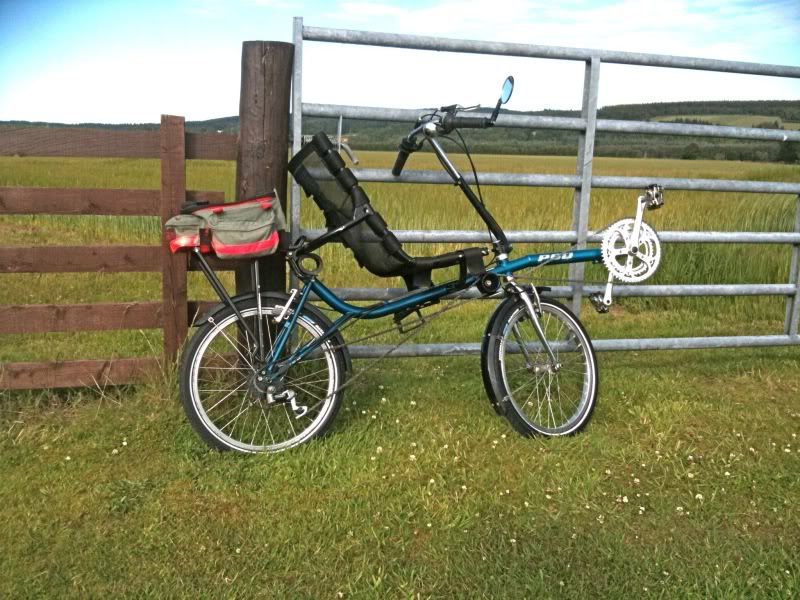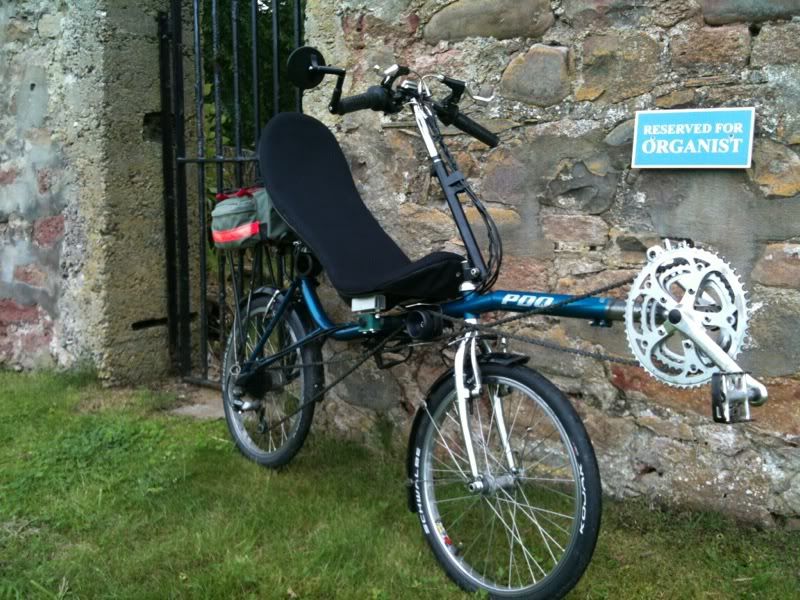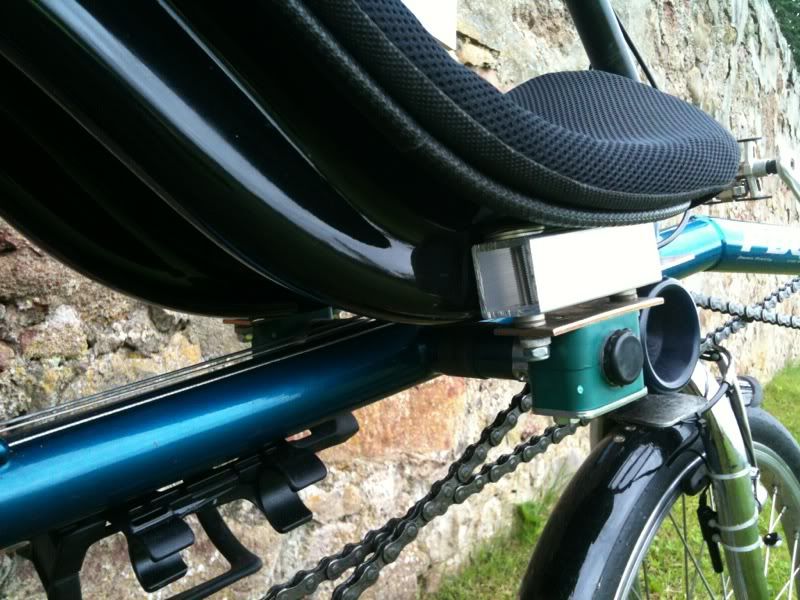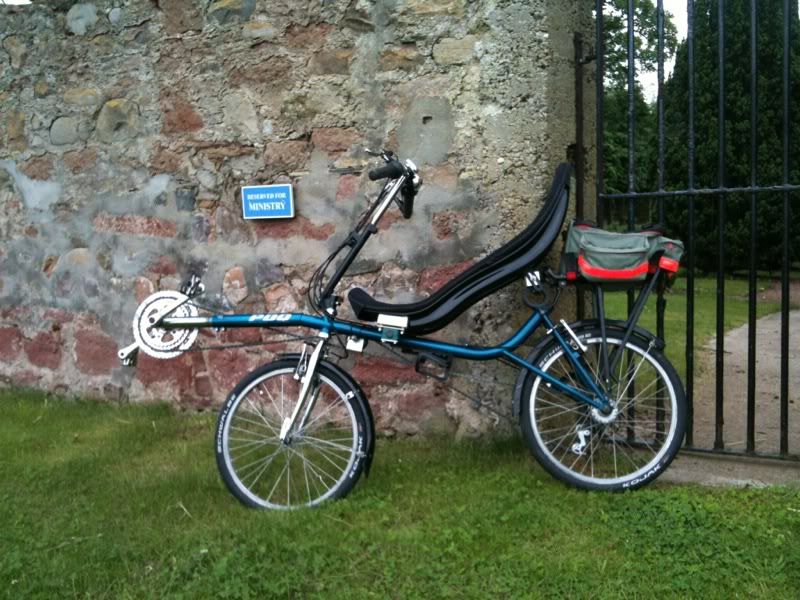The Problem
I acquired my PDQ about a year ago, largely driven out of interest (a number of years riding 'bent trikes already on my CV), but also because the bike in question was nearby and the price was right. I don't know how many previous owners it has had, but it's in very good condition. One issue was that the seat frame had been vandalised at one point and repaired, but unfortunately not perfectly, and the repaired side of the seat was bent relative to the other. This meant that the seat frame stuck in my armpit whilst riding - not a recipe for comfort. Another more fundamental issue was the nature of the seat - on the PDQ it's sort of a mesh hammock, and despite being a 20/20 SWB bike the seat is not only relatively high, getting a foot down when stopped is made harder by the shape of the "hammock". This didn't do much for my confidence, and at best I was on tip-toes when stopped. The mesh was also pretty slack, and not supportive where it needed to be.
The Plan
I was seriously thinking of selling the bike after the first six months because of the seat issues. Despite this, it's a nice bike to ride: nippy, very manoeverable at low speed (I can almost turn it in its own length at walking speed), yet very stable at 30mph. So I started looking for solutions. Skinnier tyres brought the ground half an inch closer (and made me go faster), but didn't solve all the issues. I decided to go for a hard shell seat, reasoning that I could probably mount it lower on the frame and the shape of the seat would mean getting a foot down would be an easier task. I wasn't sure about comfort: all my recumbent experiences have been with mesh seats, but anything had to be better than being poked in the armpit!
I also wanted to ensure that the conversion would be fully reversible, in case it didn't work out and I wanted to sell the bike on. The standard mesh seat also has a suspension element that is effective in reducing bigger bumps, and if at all possible I wanted to retain this feature.
Methods
A glass-fibre seat was purchased from Ocean Cycle on eBay. I was impressed with how light it was, even with the additional cushion and edging strip. It seems well made and of high quality. There's a small "nose" at the front to stop you slipping too far forward and a useful degree of lumbar support. I used hydraulic pipe clamps to fasten the seat to a length of 22mm aluminium tube put through the front seat mounting pivot tube. 30mm square tubing provided the necessary rise to clear the main tube and cupped washers (such as used to align brake blocks) dealt with the curvature of the seat relative to the mountings. At the back I invested in an Optima seat mounting and used a length of U-profile aluminium and threaded rod to connect to the suspension doughnut. At some point I'd like to replace the threaded rod with a quick release but the 80mm wide mounting will mean some modification if I use a standard wheel QR.
Results
Mounting the seat on the relatively wide pivot at the front had an unexpected effect of moving the seat forward several inches. With the mesh seat, I had the boom almost fully pushed in, but with the new seat I had to move it out several inches. Despite apparently being well greased, it required a lot of effort to move it - in the end I did so by wedging one foot against the steerer tube and pulling hard on the cranks! This required a fair bit of extra chain - fortunately I had sufficient 7 speed chain left over from an earlier DIY recumbent build.
Despite moving the seat forward, the weight distribution doesn't seem noticeably different on the road. The new seat is appreciably more reclined than the old, so that must go some way to maintaining weight distribution. The bike's original nippiness and manoueverability is maintained. There have been a couple of unforseen benefits - no more heel strike with the front wheel, and no more potential interference with knees and handlebars. There's a bolt on the riser tube which was forever trying to take a bite out of my leg - no longer an issue. I haven't yet lowered the handlebars but should be able to move them down by an inch or two, improving forward visibility.
Most importantly, the ground is now much easier to reach! The seat isn't actually much lower than before but the shape of the seat means that you can more easily get a leg down. In fact I have found myself automatically coming to road junctions and stopping with two feet flat on the ground and moving into a more upright position. It's also a lot more easy to get into the seat - with the original mesh seat it required a degree of acrobatics and manipulating the pivoting stem.
Today was the first proper try-out on the road. The engine was somewhat lacking, but everything else worked well! After a few miles I noticed how significantly more reclined the seat was than on my trikes - my neck muscles were clearly working harder! The rear suspension doughnut seemed to be doing its job as intended. I've heard that hard shell seats tend to be noisier, but with the wind whistling past my ears I couldn't detect any difference!
The new seat can be removed and the mesh seat replaced in a matter of minutes. But I don't forsee myself doing that! The chain would need to be shortened and the boom pushed in as well.
Conclusions
The Pashley will be staying. I have to say that in its original configuration it always seemed a bit intimidating, and I was forever worried about managing stops and starts. The new seat seems to make a big difference to that.
The PDQ is a very old design, and back then hard shell seats were uncommon and certainly not fashionable. Most 'bents of that time had one form or mesh seat or another - they were certainly simpler to make and didn't require complex laying of glass or carbon fibre. My experiment does show that the underlying chassis is sound. It also highlights one of the things that particularly attracts me to the world of 'bents - the opportunities to modify and adapt, or even start from scratch and create something unique in a way a diamond frame bike can never fundamentally be.
Original configuration - not really visible in this picture, but the near upright part of the seat is bent more upright than its opposite number on the far side. The boom is stuffed almost as far into the frame as it will go.

The bike is reborn! There's a lot more boom showing...

Underseat fittings

Suspension retained

That's a manual change triple chainset but does give me 3x3x7=63 gears! The doughnut compresses a bit when loaded, reclining the seat angle a bit more.
